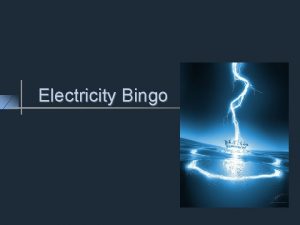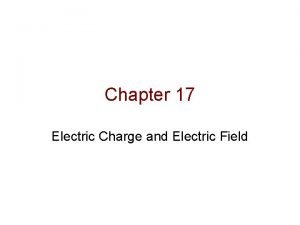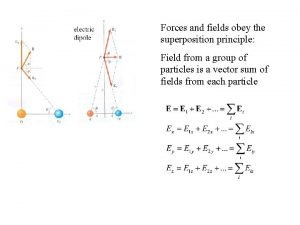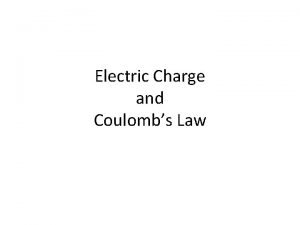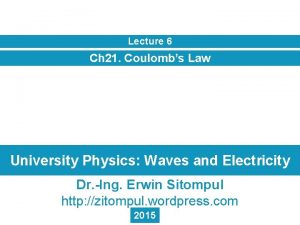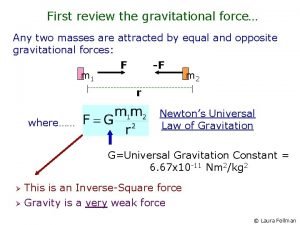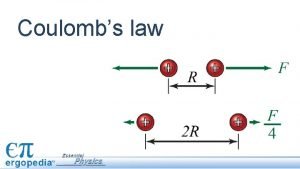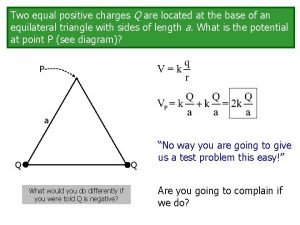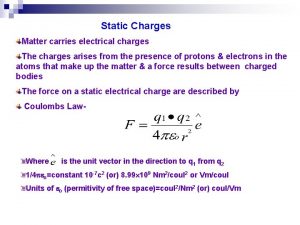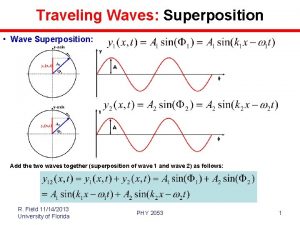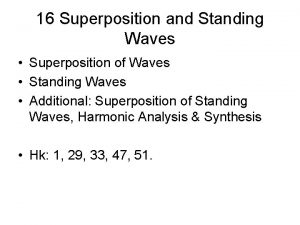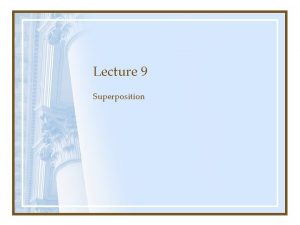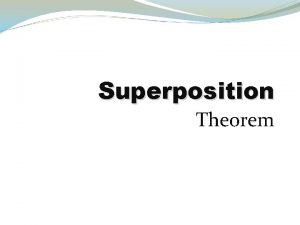Superposition of Forces Two point charges are located










- Slides: 10

Superposition of Forces • Two point charges are located on the x axis of a coordinate system: q 1 = -1 n. C and is at = -2. 0 cm; q 2 = -3 n. C and is at = 4. 0 cm. What is the total electric force exerted by q 1 and q 2 on q 3 = 5. 0 n. C at the origin?

Fields • A point charge q = -8. 0 n. C is located at the origin. Find the electrical field at the field point x = 1. 2 m and y = -1. 6 m

Different But the Same • A positron (the electron’s antiparticle) has mass 9. 1 x 10^-31 kg and charge q = 1. 6 x 10^19 C. Suppose a positron moves in the vicinity of an (alpha) particle, which has charge 3. 2 x 10^-19 C. The alpha particle’s mass is more than 7000 times that of the positron, so we assume that the particle remains at rest.

Continued • When the positron is 1 x 10^-11 m from the particle, it is moving directly away from the particle at 3 x 10^6 m/s. (a) What is the positron’s speed when the particles are 2 x 10^-10 m apart? (b) What is the positron’s speed when it is very far from the particle?

Realize Your Potential (a) An electron is to be accelerated from 3 x 106 m/s to 6 x 106 m/s. Through what potential difference must the electron pass to accomplish this? (b) Through what potential difference must the electron pass if it is to be slowed from to a halt?

Tube TVs… • An electron with an initial speed of 6. 5 x 106 m/s is projected along the axis midway between the deflection plates of a cathode-ray tube. The potential difference between the two plates is 22 V and the top plate possesses positive charge. (a) What is the force on the electron when it is between the plates?

And…

How They Work • (b) What is the acceleration of the electron when acted on by the force in part (a)? • (c) How far above the axis has the electron moved when it reaches the end of the plates • (d) At what angle with the axis is it moving as it leaves the plates? • (e) How far above the axis will the electron strike the fluorescent screen S?

What Ya Think? • If you double the amount of charge on a parallel pate capacitor, what happens to its capacitance? (i) It increases; (ii) it decreases; (iii) it remains the same; (iv) the answer depends on the size or shape of the conductors

Plates • The plates of a parallel-plate capacitor in vacuum are 5. 00 mm apart and 2. 00 m 2 in area. A 10. 0 -k. V potential difference is applied across the capacitor. Compute (a) the capacitance; (b) the charge on each plate; and (c) the magnitude of the electric field between the plates
 Mikael ferm
Mikael ferm Like charges blank and opposite charges blank
Like charges blank and opposite charges blank A point p is equidistant from both point charges
A point p is equidistant from both point charges Superposition principle
Superposition principle Coulomb's law force between two point charges
Coulomb's law force between two point charges Electric charges and electric forces lesson outline
Electric charges and electric forces lesson outline Three point charges are arranged along the x-axis
Three point charges are arranged along the x-axis Potential due to dipole
Potential due to dipole What is gravitational force
What is gravitational force Coulomb constant
Coulomb constant Potential energy of two equal positive charges
Potential energy of two equal positive charges

